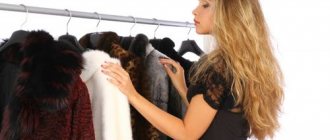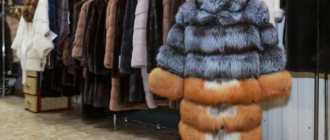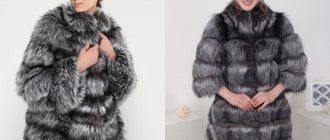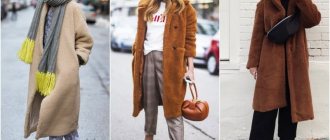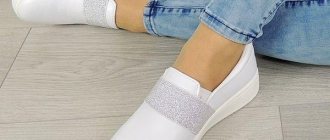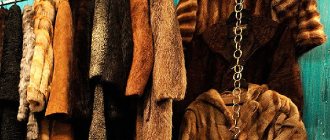Despite the large selection of materials from which outerwear is made, fur coats made from natural fur do not lose their popularity. But even in this case it is not so easy to make a choice. There are dozens of types of fur obtained from different animals. Fashionistas increasingly prefer fur coats made from arctic fox or mink. Which of these products is warm?
Arctic fox fur coat
About thermal properties
How warm the product is depends on the density and size of the fur and the stiffness of the hair. The number of air bubbles located between the villi and the density of the inner layer are of great importance. Experts often pull the core to reduce the overall weight of the finished product. But as a result, the thickness of the lining decreases, the distance between the fibers increases, and the fur coat cannot cope with frost, allowing cold air to pass through.
Experts divide all types of fur into three categories based on the thermal characteristics of the material:
- The coldest ones are goats, rabbits, ground squirrels, and ermine.
- The skins of beaver, mink, chinchilla, and arctic fox fur have mediocre properties.
- Experts consider the fur of the muton, sable, silver fox and wolf to be the most comfortable.
Based on these categories, mink and arctic fox models are in the same line. But, in addition to thermal qualities, a fur coat should be beautiful and pleasant to the touch. Therefore, it is worth considering fur from the point of view of attractiveness.
What is more expensive, mink or arctic fox fur?
The cost of a fur coat is influenced by several factors. First of all, the price depends on the type of fur. The cost is also affected by the quality of dressing and tailoring, the length and density of the pile, whole skins or pieces, the conditions and place where the animals grow and many other factors.
Traditionally, mink is more expensive than arctic fox . Mink coats are less susceptible to wear and tear than others. Prices may vary depending on the subspecies of the animal, the length of the pile and the thickness of the undercoat. As for the Arctic fox, blue fur coats will cost more than white fur products.
Currently, innovative processing technologies are used in the production of fur products.
This has led to the fact that this wardrobe item has become accessible to almost any fashionista. Today, natural fur coats firmly occupy a position in the category of items for everyday wear. [Total: 0 Average: 0/5]
Beautiful and practical
When choosing which is better, arctic fox or mink, remember that arctic fox products will keep you warm even in the most severe frosts. This fur easily tolerates air temperatures ranging from -55-600C. Plus, Arctic fox coats look amazing. Outerwear made from blue fur of an arctic fox or silver fox will look spectacular on any girl. Arctic fox fur coats are preferred by ladies from the northern corners of Russia. In harsh winter conditions, you simply cannot find a warmer and more practical option.
Painted arctic fox
Residents of central Russia are recommended to purchase mink fur coats. Compared to the Arctic fox, this is a more practical type of fur. It can withstand both frost and rainy winter weather, which is not uncommon in recent years. Today, designers offer a lot of interesting and original models of fur coats made from mink. Therefore, girls are not limited in their choice of beautiful and stylish models.
Mink coat
Fashionistas living in the southern regions of the Russian Federation are increasingly choosing products from:
- a rabbit,
- gopher,
- goat,
- ermine.
These furs are not able to keep you warm in severe frosts, but they create an excellent stylish appearance for a girl. Fashionistas often purchase fur coats from the above types of fur to wear in the off-season - autumn and spring.
Knee-length mink coat
Products made from silver fox look elegant and original. The fur has excellent thermal characteristics and is suitable for wearing on frosty winter days. However, long fibers create a voluminous effect, which may not appeal to every girl.
The most expensive furs in the world. Top 11 (with photos)
10th place: Beaver fur (beaver fur is often called “beaver”) is one of the most popular materials today, actively used to create elite fur products. It is distinguished by a number of positive qualities: pleasant to the touch, soft, flexible, fits perfectly to the figure, and its thickness and fluffiness makes the finished product very beautiful. The warmth retention and weather protection provided by its excellent response to moisture makes it even more attractive. In addition, beaver fur is one of the most wear-resistant materials: it does not go bald, does not fade, and does not dry out. The average duration of wear is 18 seasons. The color range varies from light brown to darker, sometimes almost black, shades with characteristic transitions. The price of products made from this fur material, depending on the size and quality of the fur, can be 1-2 thousand conventional units.
beaver coat:
9th place: Black-brown fox fur (another name is silver fox) is a fur popular since ancient Rus', which served not only as a material for sewing luxurious clothes, but also played a significant role in many pagan rituals. In the 20th century, the silver fox joined the upper echelons of St. Petersburg society, its dark color and luxurious hair harmonizing perfectly with the pale aristocratic skin and bright lipstick. The fur of the black-brown fox is thick, long, lush and most importantly very warm. In addition, products made from this fur material are characterized by high wear resistance. Fur shades can have several variations: from light with dark fibers to deep dark with a gray base and black splashes. The cost of a silver fox fur coat on average ranges from $1,000 to $3,000.
silver fox fur coat:
8th place: Ermine fur is truly royal fur, which has been adorning the robes of official government officials and royalty since ancient times. Not all representatives of the species have a snow-white winter outfit. The change in color depends not only on hereditary factors, but also on the habitat of the animals. For the winter, only stoats that inhabit cold regions, such as Siberia, Canada, and Lapland, dress up in white fur. Color largely depends on factors such as the presence of ice and snow cover, as well as the minimum temperature. Due to its softness and snow-whiteness, ermine has always been considered an elite material. However, despite its beauty, it is one of the least wear-resistant furs. You can buy an ermine fur coat for 2000-5000 USD.
ermine coat on Marilyn Monroe:
7th place: Arctic fox fur is a material in demand in elite circles of society. Its history stretches its roots from ancient Rus', famous for its wide abundance of furs, where the arctic fox was in quite high demand. Modern “nobility” continues to give preference to this material. As you know, in nature the arctic fox can have two colors: blue and white, and the first type is much less common than the second, which affects its cost. Blue is the fur color of a cloudy sky of varying degrees of saturation. Light blue Arctic foxes have thick guard hairs with a white base and a blue tip, which gives the overall picture a bluish veil effect. The long-haired fur of the Arctic fox is very warm, comfortable and lush, so designers often choose it to create luxurious models, the cost of which on average ranges from 2-6 thousand dollars.
arctic fox coat:
6th place: Marten fur is a material with a long history, in appearance it is very reminiscent of more expensive sable fur, but with a slightly less dense awn. It has long been valuable in Rus', and in European countries where sable is not found, it successfully occupies its niche. The color palette is very rich - from smoky gray to rich brown. The marten's hair has a thick undercoat and long pile, which makes products made from this material very durable. Skins obtained in winter are especially valued, since during this period the fur is thickest, longest and most beautiful. The main feature of marten fur is hypoallergenic, which is due to a well-ventilated structure that does not accumulate dust particles that cause allergies. Products made from practical, warm and pleasant to the touch marten fur material are valued at an average of 3-7 thousand dollars.
marten coat:
5th place: Mink fur is the material that is currently in greatest demand among manufacturers of fur products. It is usually positioned as ideal in terms of price-quality ratio. The fashion for this type of material was introduced by Hollywood stars in the 30s of the twentieth century. Silky and soft fur with thick downy and protruding guard hairs is lightweight, highly durable, practical and retains its excellent appearance for a very long time. Recently, mink fur has been subjected to all sorts of experiments: it is dyed in a wide variety of colors, lasered, cut, plucked, bleached and combined with various materials. The leaders in the production of this material are Scandinavia and North America. Mink color has a huge number of tones and halftones. The cost of an elegant fur coat made from high-quality fur from this animal can vary from $4,000 to $15,000.
mink coat
4th place: Chinchilla fur is a material highly appreciated by world experts, characterized by incredible density, lightness and silkiness. The fur of a fur-bearing animal living in South America is valued for its phenomenal density: chinchillas grow 60-80 hairs from one hair follicle, while other fur-bearing animals have only one. This density eliminates the possibility of the appearance of parasites common to other rodents. The hairline, unique in structure, is a layer of delicate and elastic fluff up to 3 cm thick. The color of the chinchilla’s fur has very beautiful shades: the dark gray back smoothly turns into bluish-smoky sides and a snow-white belly. Since the times of Indian civilization, the beauty and density of the animal’s fur have been the reason for high prices for products made from this material. At that time, the skins of these rodents were used exclusively for the robes of respected persons; they were protected and their catching was strictly controlled. Today, the cost of a chinchilla fur coat, depending on the quality of the fur, color, style and exclusivity, can range from 20 to 200 thousand USD.
chinchilla fur coat:
3rd place: Lynx fur is a rare and extremely expensive type of fur, characterized by its uniquely beautiful color. Only the soft white belly of the animal has value, and the most expensive material is considered to be the one with pronounced black spots. Fur coats made entirely from lynx fur are extremely rare; most often it is used for finishing products made from other fur materials. The cost of such luxurious clothing, depending on the name of the designer who created it, ranges from 50-250 thousand dollars.
lynx coat:
2nd place: Sable fur is perhaps the most famous material in Russia, although not every resident of the country can afford it. Since ancient times and to this day, the pride of Russian furriers is considered a symbol of wealth and luxury. Sable fur has the status of the best in the world in terms of density, quality and appearance. The hair color of this fur-bearing animal is so beautiful that designers use its skins exclusively in their natural form. The most valuable and, accordingly, the most expensive among all sable skins is the fur of the Barguzin sable, which lives on the eastern coast of Lake Baikal. In terms of its structure and abundance of shades, it is a leader among other fur-bearing animals. Particularly prized is the chocolate color interspersed with gray hair and with a blue iridescent down. By the way, it is he who enjoys the greatest popularity among world-famous couturiers. The average cost of one skin of this animal is 1.5-2 thousand USD. So, after some calculations, we can assume that even a small sable fur coat will cost 50-60 thousand dollars, and for a luxurious coat you will have to pay about 250 thousand US dollars.
sable fur coat:
1st place: Vicuña fur is the most expensive fur in the world, produced from animals living in Peru that belong to the llama family. The fur of this animal is highly valued for its remarkable properties: it is very soft, thick, thin and at the same time perfectly protects from the cold. Fur coats from vicuña fur are made extremely rarely; it is mainly used to produce high-quality woolen fabric, the meter of which is estimated at 3-5 thousand dollars. For this reason, only famous brands make clothes from this fabric. For example, the widest range of products made from vicuña fur can be seen in the collection of the Loro Piana fashion house. As for the extraction of vicuña fur, previously, as a rule, a gentle method was used, which consisted of shearing the animals. Later, the extermination of vicuñas began to increase rapidly, but after a sharp decrease in their numbers in the 60s. In the 20th century, it was decided to return to the way of our ancestors.
vicuna coat:
Choosing the right one
Not all buyers know what is more expensive: mink or arctic fox? Studying the assortment and offers of fur boutiques, we come to the conclusion that products made from arctic fox are more expensive. Products made from this fur are considered not only warm, but also beautiful. And in combination with gloves and an angora hat, an arctic fox fur coat can transform any girl.
But how to choose the right fur product so that it is not only beautiful, but also practical? It is important to consider the region and climatic conditions in which the clothing is intended to be worn.
Experts recommend:
- For the middle zone, purchase fur coats made from chinchilla and mink.
- For the northern - silver fox, sable.
- For the south - from rabbit, beaver or gopher.
We also pay attention to the filling of the product. To reduce the cost and improve thermal properties, manufacturers often use wool linings. However, if the fur is high quality and 100% natural, no lining is needed.
In order for a fur coat made from an arctic fox or mink to be warm and practical, it is important that it is sewn from whole pieces of trim. If the manufacturer used stretched scraps during the sewing process, the finished product will not be warm.
Important characteristics are structural details. we are talking about the length of the product and sleeves, the presence of a hood and a belt. Remember, the longer the fur coat, the more expensive its price. If a girl plans to be outside for a long time, it is better to purchase outerwear made from practical otter, nutria or beaver. These materials can easily withstand rainy winters and high humidity. Don't forget to choose mink and fox hats for a stunning look.
Reviews
Owners of mink and arctic fox products leave different reviews about their fur coats. Many people say that the Arctic fox is warmer, but if the frosts are not severe, it is very hot. In addition, the fur quickly turns yellow in such weather and has to be cleaned every season. Most women prefer mink coats because they are more practical, although they note that products made from arctic fox look more beautiful. Whatever fur you choose, you must remember that the most important thing in women's clothing is the woman herself who wears it!
Found a violation? Report content
How to choose a fur coat that will last for many years?
There are signs of the quality of a fur product that you need to pay attention to when purchasing.
- Kind of animal. When purchasing an inexpensive rabbit or hare fur coat, be prepared that it will last no more than 3 seasons if treated well. It will quickly lose its original appearance. For this reason, hats, fur coats, and vests for children are made from the skins of rabbits, squirrels, and hare. Children grow quickly; they do not need the product to remain durable for several years. But at the same time, such things have good thermal qualities and low cost.
- Treatment. The fur of a quality fur coat is thick, without bald spots, shiny, and elastic. The mezdra is white. It should not rattle when shaken. It is worth paying attention to how the lining is sewn. If it is not sewn tightly, this indicates that the manufacturer is confident about the quality of the product and gives the buyer the opportunity to evaluate the finishing of the skin from the inside.
- Sewing. Fur coats sewn “unfolded” and whole are allowed. It all depends on what kind of fur the product is made of. If the animal has thick flesh (beaver, raccoon, nutria), then it is usually sewn “unfolded”. In this case, the fur coat will fit better and will not look like a sheath. And if the fur is thin (mink), then a fur coat sewn “in loose” can make plump ladies look slimmer. In any case, tailoring depends on the style, length and even color of the product. Pay attention to the quality of the seams. The fewer there are, the stronger the product.
- Fur dyeing. Fur dyeing can be done for different purposes. Often the manufacturer uses it to hide defects. For this, dark shades are usually used. But there is fur that needs to be dyed, since in its original form it does not look very attractive. For example, nutria. Fur is now dyed and tinted using high-tech dyes that do not affect the quality of the product. Therefore, if you really want to buy a fur coat made of purple fox fur, then you should not be afraid. To check whether colored fur will not get dirty when worn, you need to wrap a few hairs in a handkerchief and rub it a little. If there are no traces of paint on the scarf, then you don’t have to worry about the quality of the dyeing.
- Dressing. To check the quality of the workmanship, you need to crumple any part of the fur product. It should immediately return to its original shape. To check the quality of the fur, stroke it against the grain. The down should be clearly visible, thick, and the hair should be elastic. The fur should not separate from the skin, leaving hair in the hand.
Some clever manufacturers manage to replace expensive fur with cheaper ones. So, instead of sable they can sell marten, instead of nutria - beaver and even rabbit - instead of mink. Mink and rabbit fur differ in stiffness. A rabbit's spine is much softer than a mink's. [ads2] When choosing a fur coat, you need to proceed from the possibilities of your own income and the purpose of the purchase. If you need it in order to emphasize your solidity, then you can purchase a lightweight model made of mink or arctic fox. But if you plan to spend a lot of time in the cold, then you should think about purchasing a fur coat made of mouton, fox, or wolf. When buying an inexpensive fur coat made from a rabbit, gopher or hare, you need to be prepared for the fact that it will not last long. But this option is suitable for those who like to regularly change their wardrobe. If you do not have the opportunity to often buy such expensive things, perhaps you should think about purchasing a more expensive but high-quality model. Therefore, before making such an expensive purchase, you need to carefully weigh everything, think it over and choose the appropriate option in terms of means and application.
Wearability of a fur coat
The price of a fur product does not allow many women to buy them often. Therefore, when making a choice, it is important that you like the fur coat, be practical, warm in the cold and be easy to care for. The main property of fur is wearability.
Factors affecting wearability:
- compliance with dressing and dyeing technology;
- wear resistance of leather, fur;
- strength of the bond between hair and skin.
The most durable otter fur was chosen as the standard for wearability.
A fur coat made from the skin of this animal has a maximum coefficient of 20 seasons. Therefore, the wearability of all other products is compared with this figure. It is very easy to determine how long outerwear made of fur will look worthy.
Fur coat manufacturers suggest that you familiarize yourself with the following information:
| № | Fur | Number of seasons | Fur wear in % |
| 1 | Otter | 20 | 100 |
| 2 | Wolverine | 19,5 | 98 |
| 3 | Beaver | 95 | 95 |
| 4 | Sable | 14 | 80 |
| 5 | Raccoon | 13 | 75 |
| 6 | Mink | 10 | 70 |
| 7 | Arctic fox | 7,5 | 65 |
| 8 | Marten | 7 | 60 |
| 9 | Astrakhan | 7 | 60 |
| 10 | Sheepskin | 6 | 50 |
| 11 | Fox | 5 | 45 |
| 12 | Muskrat | 5 | 45 |
| 13 | Nutria | 4,5 | 40 |
| 14 | Ferret | 4 | 35 |
| 15 | Squirrel | 3,5 | 30 |
| 16 | Marmot | 3 | 27 |
| 17 | Ermine | 3 | 25 |
| 18 | Rabbit | 2,5 | 12 |
| 19 | Gopher | 2 | 10 |
| 20 | Hare | 1 | 5 |
The wear rate also depends on other factors. For example, from the methods used to process fur, the experience of the manufacturer and adherence to the technological process. Winter fur is considered to be of the highest quality. It has great density and thick down. In the summer, animals shed, because of this, the fur does not hold the hair very firmly. There may be barely noticeable bald spots on the skin.
Some technological processes can reduce or, conversely, increase the wear rate. Painting reduces wear by up to 25%, and cutting it increases wear by up to 40%. Changing the length of the pile of ermine or rabbit products reduces thermal insulation.
Distinguishing fur
It often happens that the fur seems to be natural, but not from the animal that the seller insists on. In order not to buy cheap fur for crazy money, remember the following:
- – mink fur can be replaced with the fur of a rabbit, marmot or steppe mink. Real mink fur feels like oil and has a dense, even pile. Its hairs are of equal length, with a soft undercoat. Each villi tapers from root to tip. Mink skins are monochromatic, but the degree of coloring should be different.
- -beaver fur has a dense undercoat. It feels very soft and fluffy. Usually they try to pass it off as nutria fur, which is tougher and shorter.
- -silver fox fur is long and soft to the touch. Each of its fibers includes three shades of color.
Features of mink
Mink coats have become popular due to the ratio of price and quality of fur. Scandinavian mink occupies the main market share, in contrast to the expensive North American species and the cheap Russian one. It is distinguished by thick, short guard hair and a dense, shiny undercoat. Mink coats are warm and cozy in frosty and rainy weather. Mink lives on land and in water, so its fur easily tolerates high humidity.
Southern mink does not have as thick an undercoat as mink bred in North America, Finland, Alaska and Western Canada. The Diana Furs company, like other factories, uses whole and cut skins when sewing mink coats. Due to the plasticity of fur, they can be processed as easily as fabric. They sew long and short mink coats of different styles, coats, and jackets. The fur is bleached, sheared, plucked and dyed in various colors. Photo printing or heeling is applied to it, and a mink coat is combined with leather and other elastic materials.
A mink coat can be worn for 10 seasons without losing its softness and shine. Its wear resistance is inferior to sable, beaver and otter, whose fur can be worn from 12 to 20 seasons.
A fur coat made from the valuable fur of fur-bearing animals is selected taking into account its appearance, ability to retain heat, duration of wear and difficulty of care. Weigh the pros and cons and think about the future so that the cost of the fur product pays off over a long service life.
Disadvantages of their fur products
Arctic fox fur coats or vests, like any other product, along with advantages, also have some disadvantages:
- The main thing that the owner of such outerwear should be prepared for is careful care . In the wardrobe it should only be stored on a trampoline with wide hangers. This fur does not tolerate being close to heating devices, so if exposed to rain or wet snow, the fur coat should be dried only at room temperature, after hanging it on a trempel.
- You should not wear handbags or hard belts over fur, as natural scribe has a delicate pile and may suffer from friction . You also need to take into account that an arctic fox coat can more easily withstand traveling in a personal car, but not in public transport.
- When buying a fur coat, you also need to purchase a special brush for regularly combing the fibers.
- After the end of the season, the arctic fox coat must be prepared for storage . Inept independent actions can lead to disastrous results, so you will have to spend money on dry cleaning. This fur actively attracts dust, so regular cleaning is necessary to prevent it from losing its shine or changing color due to dirt.
- Arctic fox fur has long fibers and products made from it look voluminous, so it is difficult for ladies with large sizes or short stature to choose a suitable model that will not emphasize the shortcomings of a large figure .
- Arctic fox fur needs to be protected from harmful insects that can harm it using special means, but in no case should you use naphthalene because of its specific odor, which is difficult to get rid of as it is absorbed into the fur.
Furs from wild-caught animals
Expensive items are made from the skins of marten, lynx, wolf, sable, chinchilla, and beaver. The approximate cost of one model is from 100 thousand rubles and above.
Chinchilla short fur coat
Sable is considered the royal fur. Thick and warm skin is durable and practical. The beast is caught in the taiga. In captivity, bred sable does not have such luxurious hair.
Chinchilla
The unique rodent hair is famous for its density and shades. The color of the hair changes color from the top to its base, creating amazing iridescence. Animal skins have a high cost, and many manufacturers replace them with analogues made from dyed rabbits.
Beige chinchilla fur coat
Which fur coat is more expensive: chinchilla or astrakhan fur? The cost ranges from 300,000 to 700,000 rubles. Short models and vests have the lowest price for which you can buy a classic astrakhan fur coat.
Chinchilla fur coat
Features of the Arctic fox
Arctic, white, and snow fox are nicknames for the Arctic fox, which is recognized by its long, multi-layered and fluffy hair. The animal, having inhabited the tundra zone of the Northern Hemisphere, adapted to the severe frosts of the Arctic and life on the ice floes of the Arctic Ocean. Its fur retains heat well at extremely low air temperatures.
Arctic fox models are distinguished by thick, warm, thick, uniform fur. It is much softer than mink fur. The skins are tanned from the end of January to the end of February - the season when the fur of the polar inhabitant takes on its best appearance. In the summer it changes color, which in the wild helps it blend in with its surroundings.
Arctic fox species
The cost of a fur coat depends on whose fur was used: a white or blue polar animal. White Arctic foxes inhabit the mainland tundra of North America, Eurasia, the Scandinavian and Kola Peninsulas. Products made from white fox are cheaper than those made from blue fox, which lives on the islands. As a species class, it is much smaller. Blue Arctic fox coats are highly prized and cost several times more.
The white fox fur coat is distinguished by its snow-white color, which is easy to dye and allows you to achieve a uniform color of the finished product. In summer, the white subspecies of the Arctic fox turns brown and gray. The blue arctic fox, which lives closer to the North Pole than its mainland counterparts, is distinguished by a denser and higher underfur and long white guard hairs. It is characterized by dark gray, light brown and silver color with a blue tint.
Blue fur coats are rarely dyed so as not to cover up the natural beautiful color. Only the tips of the guard hairs can be painted, creating the effect of an airy veil covering the fur. The white arctic fox is often painted 2-3 colors or bleached. This treatment removes the unwanted yellow or gray tint.
The Arctic fox has lush, soft and warm hair that does not lose its shine and retains its appearance for 7 seasons. Among other fur-bearing animals, the arctic fox is rated 60 points in terms of wear resistance. The fur coat of the blue fox subspecies lasts several seasons longer. Coats, muffs, hats, collars, cuffs and decorative elements for outerwear are sewn from soft fur.
The Arctic fox can be restored and repainted. Places with frayed pile are replaced with fur pieces, and the entire product is repainted if the new inserts are very different from the fur coat.
